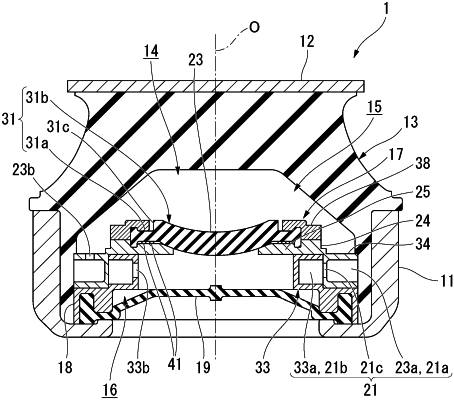| CPC B60K 5/1283 (2013.01) [F16F 13/105 (2013.01); F16F 13/107 (2013.01)] | 20 Claims |

|
1. An anti-vibration device comprising:
a tubular first attachment member that is coupled to any one of a vibration generating part and a vibration receiving part, and a second attachment member that is coupled to the other thereof;
an elastic body that couples the first attachment member and the second attachment member to each other; and
a partition member that partitions a liquid chamber in the first attachment member into a main liquid chamber having the elastic body in a portion of a partition wall thereof, and an auxiliary liquid chamber,
wherein the partition member includes
a membrane that forms a portion of the partition wall of the main liquid chamber, and
an orifice passage that extends from the main liquid chamber toward the auxiliary liquid chamber,
the orifice passage includes a main liquid chamber-side passage that is located on the main liquid chamber side and an auxiliary liquid chamber-side passage that extends from the main liquid chamber-side passage toward the auxiliary liquid chamber,
the main liquid chamber-side passage and the auxiliary liquid chamber-side passage extend in a circumferential direction and are disposed at mutually different radial positions,
a flow direction in the main liquid chamber-side passage and a flow direction in the auxiliary liquid chamber-side passage are opposite to each other when liquid flows through the orifice passage,
a channel cross-sectional shape in at least one passage of the main liquid chamber-side passage and the auxiliary liquid chamber-side passage is formed such that an axial size measured in an axial direction along a central axis of the first attachment member, and
a ratio of the radial size to the axial size in the one passage is larger than the ratio in the other passage of the main liquid chamber-side passage and the auxiliary liquid chamber-side passage.
|